Some versions of this sensor support Remote Data Logging.
Which sensors are equipped with the remote data logging feature?
Troubleshooting
General: Press the power button on the sensor to turn it on. Connect your sensor as described in the Getting Started instructions for your device.
- Primary Test: Place the sensor in distilled water. The reading should be at or near 0 ppt. Place the sensor in a 35 ppt salinity standard solution. The reading should be at or near 35 ppt.
- Secondary Test: Place the sensor in distilled water and then move the sensor to a container of tap water. The readings should change from 0 ppt to a salinity value that is appropriate for your region of the country.
Additional Troubleshooting
- Can I use Vernier water quality sensors in salt water or in a salt water aquarium?
- What is the difference between salinity and conductivity?
REMOTE DATA LOGGING
- Which sensors are equipped with the remote data logging feature?
- Is there a way to update Go Direct sensors with the remote data logging feature?
- Remote Data Logging Troubleshooting and FAQs
- How long will my battery last for my remote data logging experiment?
- How do I configure multiple channels of my Go Direct device for remote data logging?
- How do I start a remote data logging experiment on a triggering event?
- How do I check the status of my sensor during a remote data logging experiment?
- How do I bring remote logging data from multiple devices or multiple runs into a single Graphical Analysis file?
Specifications
- Sensor: dip type, epoxy body, parallel platinum electrodes
- Range of Salinity Sensor: 0 to 50 ppt (0 to 50,000 ppm)
- Accuracy (factor calibration)
⚬ below 35 ppt: ±1.5 ppt
⚬ above 35 ppt: ±5 ppt - Accuracy (user calibration)
⚬ ±0.5 ppt within user-calibrated range - Response time: 90% of full-scale reading in 1 s.
- Temperature compensation: automatic from 5 to 35 °C (can be turned off)
- Temperature range (can be placed in): 0 to 80 °C
- Dimensions: 12 mm OD and 150 mm length
- Sensor units
⚬ Salinity: ppt, ppm, mg/L, μS/cm, dS/m
⚬ Temperature: °C, °F, K - Connections:
⚬ Wireless: Bluetooth® v4.2 (wireless range 30 m unobstructed)
⚬ Wired: USB 2.0 full speed - Battery: 300 mA Li-Poly
⚬ Battery Life (single, full charge): ~24 hours continuous data collection
⚬ Battery Life (lifetime): 2 – 5 years (typical)
Calibration
Calibrate? For many experiments, calibrating the Salinity Sensor is not required. We store a calibration equation on each sensor before shipping it, which is used as a default by our software.
For the most accurate measurements with this sensor above 35 ppt, we recommend calibration. It is a simple process that takes only a few minutes. For instructions for Salinity Sensor calibration, see How do I calibrate my sensor?
CALIBRATION SOLUTION
If you choose to calibrate the Salinity Sensor, you will want an accurate standard solution. Vernier sells a 35 ppt Salinity Standard (
Note: The Practical Salinity Scale 1978 was developed relative to a KCl solution. Standard Methods for the Examination of Water and Wastewater states that “A seawater with a conductivity at 15°C equal to that of a KCl solution containing a mass of 32.4356 g in a mass of 1 kg of solution is defined as having a practical salinity of 35.”
Battery Troubleshooting
- If the sensor can be turned on when connected by USB but not when disconnected from USB, the battery either needs charging or has reached its end of life and can no longer hold a charge.
⚬ First, try charging the sensor for several hours. - If the sensor still won’t turn on when disconnected from USB, try swapping the battery with a working sensor to see if the problem follows the battery or stays with the sensor.
⚬ If the problem stays with the sensor, the battery is probably not the issue.
⚬ If the problem follows the battery, the battery has likely reached its end of life. - If you intend to use this sensor wirelessly, its battery will need replacing.
Go Direct® 300 mAh Replacement Battery (GDX-BAT-300 ) - See How do I replace the battery in a Go Direct Wand-Style Sensor? for more information (including a video).
Rechargeable batteries are covered by a one-year warranty.
Batteries should last two to five years in typical use.
Related Products
- Salinity Standard (
SAL-ST ) – 35 ppt - Micro USB to USB-C Cable (
CB-USB-C-MICRO ) - Go Direct® Charge Station (
GDX-CRG ) - Electrode Support (
ESUP ) - Go Direct® Sensor Clamp (
GDX-CLAMP ) - Go Direct® Conductivity Probe (
GDX-CON ) - Salinity Sensor (
SAL-BTA )
Replacement Parts
- Go Direct® 300 mAh Replacement Battery (
GDX-BAT-300 ) - Micro USB Cable (
CB-USB-MICRO )

